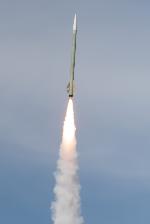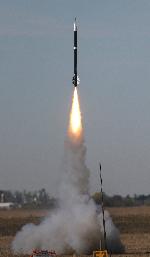Dark Energy
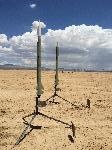
| Diameter: | 4.02" | Type: | Sport |
| Length: | 96" | Status: | Repairs - 6 flights |
| Motor Mount: | 76mm | Build Dates: | 2010-07-10 to 2010-11-13 |
I really like the looks of the DarkStar design, and I really like the records that Milton Jackson & Shur-I-Kan put out on Dark Energy recordings. So I figured it'd make sense to put the two together. (It's not a bad rocket name, either!) A quick e-mail to the duo got me a nice big logo, which Randy Milliken cut out of some vinyl for me; I picked up a brand new Extreme DarkStar kit at the June Walcott launch, and away things went. I assembled most of the kit over the summer of 2010, at my apartment and on the back porch of my friend Tom's house. The kit went together well, and will act as a nice complement to the Competitor 4 and Arcas in the 4"/3" rocket category.
Flights
My one and only flight for the weekend was Dark Energy making its triumphant return to M power with an M3100WT. And since I knew he had both a Darkstar and an M3100, I bugged Greg Smith to drag race--and of course he obliged! We set up on 41 and 42, and after some gentle prodding, Jay Orr gave us an amazing sendoff. Greg beat me off the pad with his pyrogen-tipped igniter, but I was right on his heels, and holy cow did those things move out: laser beams up to the big, puffy clouds in the sky. People were hollering after the thunder let up-it was great. We both had drogues and mains appear on cue, but Greg somehow landed next to the port-o-john while I had to take a hike across 247. We both got em back in one piece, ready to do it again!

others: prepped on the pad
I reused the nose cone tip, so it's officially a rebuild, right? Since the last time this rocket flew, the record label folded, so I'm not sure what to do about that. I added a tailcone and chopped the length on the rebuild to make it look more to my liking. For a shakedown, Jason offered me an L850W at a good price. Justin Farrand provided a table for me to work on, and also shot a great video of the flight (thanks dude!). The up part was nice and smooth with drogue deployment clearly visible; main deployment was on time too, one field up and one field over (right next to where Eric's L2 landed last year). I picked it up and schlepped it out of the field with no damage. Yea!
In anticipation of the December research launch, I mixed up a big batch of Ultra Violet with Tom and Brittany. And what better way to show it off to the Indiana Rocketry crowd for the first time than in a 6000 case? The M4500 is one of my favorite motors to fly, and it didn't disappoint in Dark Energy. The flight rocked to close to 12,000'. However, for some puzzling reason (bad e-match is the leading contender), apogee came and went without an event. The rocket came in hot to 700', where the main fired in a futile attempt to slow the rocket down; DE landed hard, trashing the avionics and breaking all sorts of things. Parts for the rebuild are already on the way -- it'll be back soon!
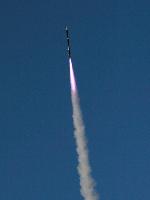
others: liftoff
I had spent the Super Bowl alternately watching football and mixing a big batch of White Knight, but had yet to fly any of it. I prepped the motor the week before the launch (getting out some area exam stress sanding grains!), so prep was fairly quick on Saturday morning. I replaced the avionics batteries, got GPS lock, and hooked up the recovery rigging with a nice shiny new 60" SkyAngle chute. Dennis Watkins again volunteered to watch the GPS data, and David Kittell not only carried my rocket to the pad, but gave me an igniter to use -- thanks man! Tim called out the count and the motor lit up with a satisfying roar, carrying the rocket into the air on a long burn. At apogee, a small gas leak into the avionics bay tricked the altimeters into thinking it was at main deployment altitude, leading to main deployment and a long walk. Dennis tracked it faithfully with his yagi, and the BRB GPS led me and Richard Cash right to the airframe laying quietly in a corn field 2 miles away. Cool motor, and not a bad flight!
I had prepped Dark Energy with a 6000 load for the December research launch, but my GPS crapped out before I got the flight in the air, so I didn't get to fly. The research day was blown out in January, so I spent the afternoon machining a motor adapter on my friend Tom's lathe, to allow my one remaining Gorilla 2550 load to be mated into the 3” mount. I also put a finicky ARTS in the payload bay to see what data it could record. The rocket was prepped, and I built the motor the night before with the assistance of Jacob and Clare (who claimed the propellant smelled wrong, what a double-base snob ;)), so on launch day, it was a quick prep job to open the avbay to turn on the tracker and connect the two sections at the drogue bay with a quick link. Gus Piepenburg helped me put it on the rail and arm the avionics, and with a quick five-count, we were on the way. The igniter took a second to light the motor - the sparky propellant was tough to light, plus there appeared to still be mold release on the core. But no matter, once things got going DE picked up smartly off the pad and crackled into the air. The smoke charge made things visible after burnout, and drogue deployment was on time. The rocket glinted off the sun on the way down, and main deployment happened at 700' just a few hundred yards away, one field over.
Things always crop up at the end of builds which make the first flight a challenge, and this one was no exception. I worked frantically through the night on Saturday readying the vehicle (thanks again Tom, Ben, and Ean for letting me use the garage) and still had lots to do on Sunday morning at the launch site. I had cast a 5 grain 76mm Blue v3 load earlier in the summer which would make for a nice first flight. Justin Farrand was kind enough to loan me his AMW 6000 hardware, and also donated a smoke grain (thanks again man!). While I worked on the avionics bay, David Hailey and Tom Feldman assembled the motor, and Tom's girlfriend Pam and Jacob Dennis worked on getting the Beeline GPS secured into the nose cone. After buttoning up the bay, disaster struck when my ARTS (severely beat up from the Competitor flight a few weeks ago) only detected continuity on the main channel; some quick thinking and I added a PerfectFlite for deployment control, with the ARTS along for data. Everything was finally ready to go at about 3:30 PM. Roger Jezler was kind enough to donate an igniter, and Gus Piepenburg loaned the use of his rail. After loading on the rail, arming avionics, installing the igniter, and a few quick photos, Brian Perry called out the count. The igniter fired and the motor lit up with authority, cranking DE off the pad. It quickly became invisible against the high cirrus cloud layer, but a pop wafted down from above, indicating we had a drogue. Pam passed the GPS receiver over to me and I called out the altitude and location on the way down; when signal was lost, we knew where it was. Tom and Pam ran out for a quick check, but noted that the rocket was over a small rise; since they needed to leave, Tom left his iPhone with me (loaded with the coordinates), and I was able to walk straight to the rocket on the first try. (That GPS is SLICK!) The ARTS beeped out 12,275 and the HiAlt reported 12,336 -- not a bad first flight.
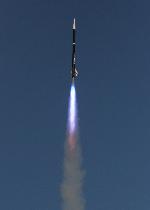
others: obligatory dumb rocket picture | recovery
video
